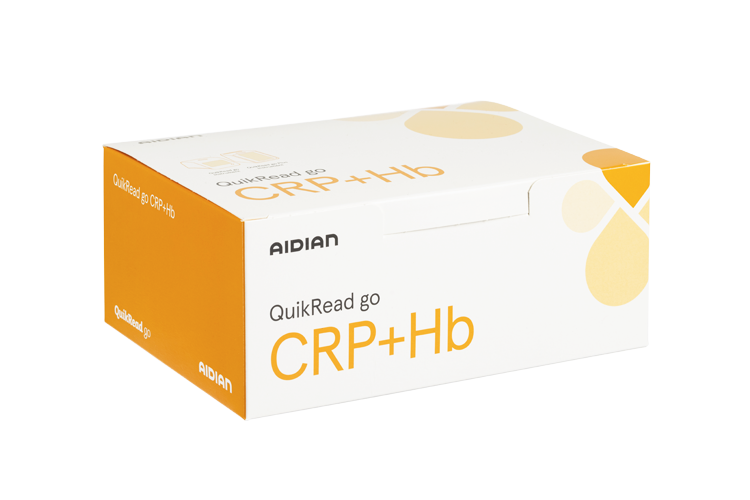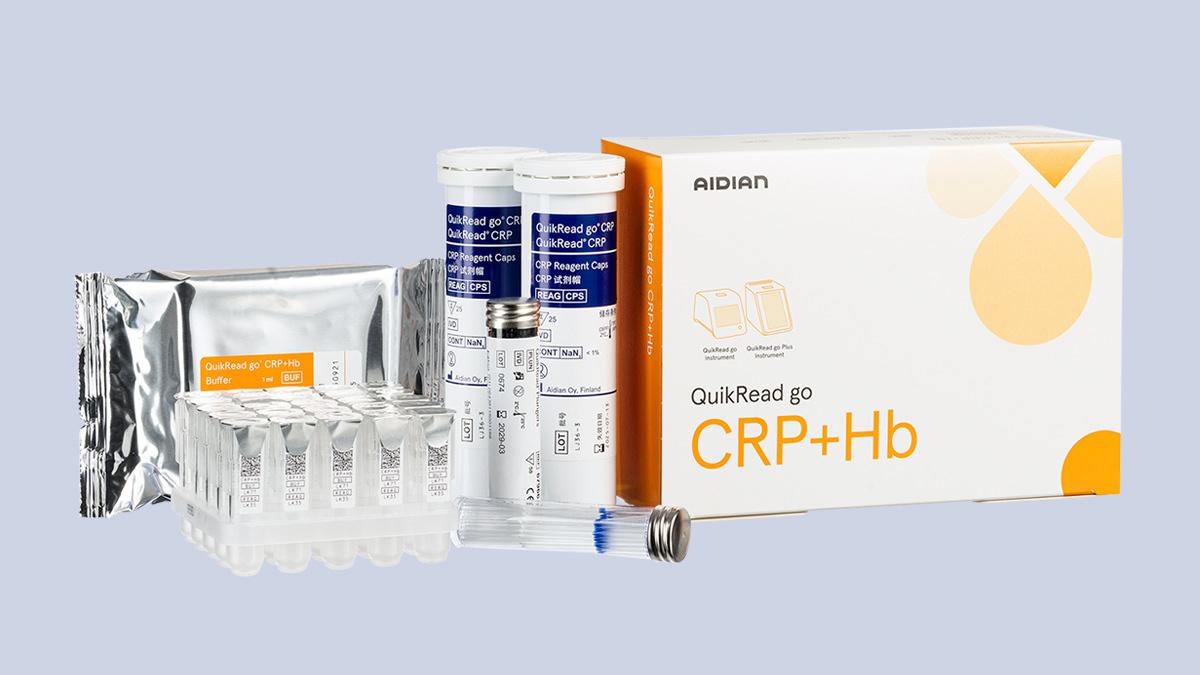QuikRead go CRP+Hb
QuikRead go CRP+Hb is a fast and simple rapid test for quantitative determination of C-reactive protein (CRP) in whole blood, serum, and plasma and haemoglobin (Hb) in whole blood with QuikRead go instrument. The test provides two precise results, CRP and Hb, from a single sample with one analysis.

Generally
Versatile point of care CRP testing with QuikRead go CRP+Hb
Accurate C-reactive protein (CRP) measurement is essential in managing patients with symptoms of infection and inflammation. A fast CRP test helps to identify patients who benefit from antibiotic treatment, and it is valuable in monitoring treatment responses1. The test can also be used for the evaluation and monitoring of inflammatory conditions2. The easy-to-use QuikRead go CRP test can be used near the patient providing immediate CRP result.

Haemoglobin measurement gives important information about the patient’s condition in both acute and basic healthcare settings. Changes in haemoglobin concentrations can be seen in several medical conditions which makes haemoglobin measurement one of the most commonly used diagnostic test.
Simple sampling
- No manual steps
- Wide automatic haematocrit correction for CRP results
- Finger prick or venous whole blood sample. Plasma or serum can also be used
One fast analysis – two results
- A single analysis provides both CRP and haemoglobin results
- Combined analysis time 2 minutes
- CRP measuring range 5 - 200 mg/l* and haemoglobin 50 - 245 g/l
- Results are comparable to laboratory tests
Effortless testing with the QuikRead go multianalyte instrument
- Ready-to-use reagents
- Fully automated measurement
- Maintenance free
- Battery use ensures full portability
- Bi-directional connectivity to most HIS and LIS systems
*with whole blood and haematocrit of 40%, with plasma and serum 5 – 120 mg/l
Test results should never be used alone, without a complete clinical evaluation.
This version of QuikRead go CRP+Hb is not registered in the USA.
References
- Van Hecke O et al. Guidance on C-reactive protein point-of-care testing and complementary strategies to improve antibiotic prescribing for adults with lower respiratory tract infections in primary care. Front. Med. 2023; 10: 1166742.
- Markanday A et al. Acute phase reactants in infections: Evidence-based review and a guide for clinicians. Open Forum Infect Dis. 2015; 2:ofv098.
Technical data
| Products available |
|
| Use | For in vitro diagnostic use, IVD CE |
| Method | Immunoturbidimetric and photometric |
| Sample type | CRP: whole blood, serum, plasma. Hb: whole blood. |
| Instrument information | QuikRead go system instruments |
| Measurement time | 2 minutes |
| Reading of the result | Instrument read |
| Storage | 2 - 8 °C |
| Size and weight | 190 x 140 x 80 mm / 0.515 kg |
| Additionally needed |
|
| Country of origin | Finland |
| Registration | Not registered in the USA |
| Registered trademark | QuikRead go is a registered trademark of Aidian Oy |
About C-reactive protein (CRP)
CRP aids clinical management of patients with infections or inflammatory conditions.
Learn more: About C-reactive protein
About hemoglobin
Hemoglobin is the molecule which contains iron and transports oxygen in the blood. It binds oxygen in the lungs, transports it to tissues and returns carbon dioxide from tissues to the lungs. Hemoglobin has an important role in the body’s iron cycle and it contains most of the functional iron in the body.
If a patient has anemia the blood hemoglobin or red blood cell concentration is below recommended levels. Anemia has many different causes but iron deficiency, which causes iron deficiency anemia, is the most common cause in the Western world. It should be remembered that anemia is more of a symptom than a disease. Hemoglobin tests may help diagnose anemia but the cause of anemia has to be investigated.
References
- Dacie and Lewis. Practical Haematology, 11th edition, 2012.
- HoffBrand and Pettit. Essential Haematology, 3rd edition, 1997.
- Ruutu. Rajamäki, Lassila, Porkka. Veritaudit, 3rd edition, 2007.
Antimicrobial resistance and CRP
Antimicrobial resistance is a global health threat. CRP point of care testing aids management of respiratory infections and fighting against antimicrobial resistance.
Learn more: Antimicrobial resistance and CRP
Documents and materials
Marketing and sales materials
QuikRead go CRP+Hb Brief Instructions (EN)
CRP control procedure Brief Instructions (EN)
Hb control procedure Brief Instructions (EN)
QuikRead go Plus Family Brochure (EN)
QuikRead go Family Brochure (EN)
QuikRead go Plus Technical Specifications (EN)
QuikRead go Technical Specifications (EN)
QuikRead go Control Information (EN)
Instructions for Fingertip Blood Collection (EN)
QuikRead go workstation Flyer (EN)
The Benefits of CRP Point-of-Care Testing in General Practice (EN)
Instructions for use
(For informative use only. Kindly always refer to the latest package insert in the kit.)
QuikRead go CRP+Hb IFU (GB, DE, FR, IT), 140068
QuikRead go CRP+Hb IFU (CZ, SK, HU, PL), 140068
QuikRead go CRP+Hb IFU (ES, PT, NL, SI), 140068
QuikRead go CRP+Hb IFU (FI, SE, HR, GR), 140068
QuikRead go Hb Control IFU (GB, DE, FR, ES, IT, CZ, HU, PL, SK, SI, SE, NO, DK, FI), 141154
Safety Data Sheet
If you wish to receive a Safety data sheet, please contact: product.support@aidian.eu
Videos
-
Test videos using QuikRead go Instrument
-
Test videos using QuikRead go Plus Instrument
Frequently asked questions
I opened the lid of a cuvette but I did not use the cuvette immediately. How long is the cuvette usable?
You should use the cuvette within 2 hours of opening it.
Can I use CRP controls with the QuikRead go CRP+Hb test kit?
Yes, you can use the same CRP controls with the QuikRead go CRP and QuikRead go CRP+Hb tests. The target values are valid for both tests.
Do I get a hemoglobin result automatically from every measurement if I use QuikRead go CRP+Hb test?
Yes, you automatically get both CRP and hemoglobin results each time from whole blood samples. If plasma or serum samples are used, you only receive a CRP result. This is because plasma and serum samples do not contain red blood cells and, therefore, do not contain hemoglobin.
Is it enough to take only one capillary sample (not two replicates) to get a reliable hemoglobin result?
We have evaluated the difference between parallel samples with the QuikRead go CRP+Hb test and we do not see any need for two or more parallel samples. The Hb results received with the QuikRead go CRP+Hb test are comparable to laboratory results and to the gold standard methods, and they require a single sample only. It is always important to pay attention to proper sampling technique.


